This Shrimp Lo Mein is quick and easy to make at home and is sooooo much better than any take-out.
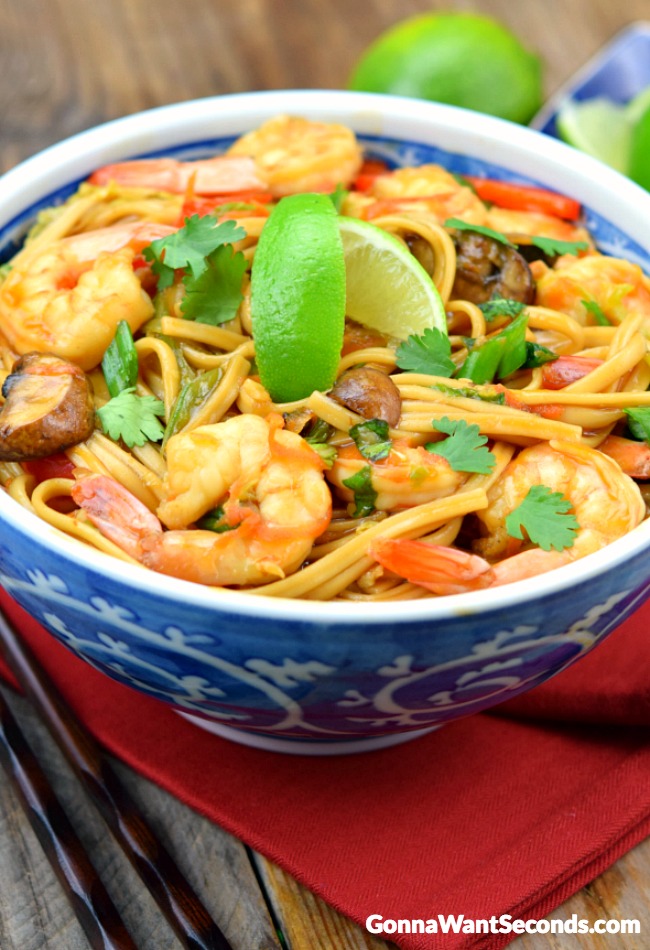
Be Sure To Follow Gonna Want Seconds on Pinterest for more great recipes!
There’s a small group of recipes that can truly be called “one pan” recipes. This shrimp lo mein dish is absolutely one of them. It’s a great recipe to make any time, because it cooks up in only 15 minutes or so—in ONE PAN! That means less cook time, less cleanup, and less work! Who doesn’t want that?
And shrimp lo mein is really good. It has always been one of my favorite things to order at a Chinese restaurant—and now I can make it up in 15 minutes in the comfort of my own home. Much, much easier than going out to get it.
Plus, when I make this dish at home I get to know—with certainty—every single ingredient that goes into this dish. Now, is shrimp lo mein healthy? Pretty much. With shrimp lo mein calories aren’t a huge concern. There’s not a lot that goes into this dish that you need to be concerned about.
But making shrimp lo mein at home adds that extra layer of protection over the ingredients. You don’t need to worry about getting an MSG a headache after dinner. (Even if you order your takeout without any MSG, who knows if the chef is really even getting that memo.)
Plus, making shrimp lo mein at home means you can control the quality of ingredients used. I know for sure that I’m using a high quality, fresh shrimp. (Just consider how important that is, for a second.) And I know that the vegetables I’m using aren’t just from a bag of frozen veggies, but were picked out by me at the store.
There are lots of benefits to making this dish at home. Give it a try and tell me why you like homemade shrimp lo mein!
Recipe Notes:
Preparation: This is perhaps the most vital thing I can tell you before you begin making this recipe: you need to have gathered and prepared all of your ingredients before you start making this recipe. Have everything chopped and grated and sitting out on your counter. The recipe comes together really quickly, so there won’t be any time to prepare other ingredients while you cook.
Pan: I love cooking in my wok. Anything I can get away with cooking in it, I do. And if you happen to have a good stainless steel wok, you’re going to want to pull that out. It’s the best tool for the job. But, if not, a large stainless steel skillet will work as well. This is not a job for a Teflon pan!
Noodles: The noodles used in this dish are a type of Chinese noodle made of wheat. They’re used a lot in stir-fried noodle dishes, as you can imagine. In fact, the world “lo Mein” is derived from the Cantonese word for stirred noodles. These lo mein noodles tend to be thicker and dense than some other familiar Chinese Noodles.
If for some reason you can’t find Lo Mein noodles, you can use capellini noodles instead. They are a great substitute, and you can find them in most stores. Of course, using the; noodles won’t yield you an authentic lo mein recipe… but you’ll still get a dang delicious meal!
Before you add the cooked noodles to the wok (or your large skillet), make sure that they aren’t mushed together in a big clump. That won’t be helpful to you as you’re trying to cook them and spread them evenly throughout your shrimp and vegetables. If your noodles are all stuck together after boiling, you can de-clump by rinsing them under warm water and draining them well before adding them to your wok.
Shrimp lo mein vs. Shrimp chow mein: Lots of people use “lo mein” and “chow mein” interchangeably, but that’s not accurate. They actually describe two different dishes. Both dishes use the same wheat noodles. However, when making shrimp lo mein, the noodles are boiled to softness. When making chow mein, you should cook the noodles until they are crispy.
Cabbage: Are you familiar with Napa cabbage? If you’re not, let me introduce you to your new favorite cabbage. Napa cabbage is known throughout the world as Chinese cabbage. You’ll find it in all kinds of dishes, most commonly in Asian dishes. That makes it absolutely perfect for this shrimp lo mein. The Napa cabbage has a sweet, mild flavor that I’m quite fond of—I use it a lot when cooking with cabbage. Even if you’re not incredibly fond of cabbage, you just might like the milder taste of the Napa. I call it a “game changer.”
That being said, regular old cabbage is quite a bit cheaper than Napa cabbage. So if you’re looking for a budget-friendly alternative to the Napa, regular cabbage is a great choice.
On nights when I don’t have an extra five minutes to spare, I’ll use the angel hair pre-shredded cabbage instead. Using that is an awesome time saver—and frankly, the flavor is just as good as when I hand cut the regular cabbage myself.
Chinese 5 Spice: If you guessed that this is a blend of five different spices commonly used in Chinese cuisine, you are absolutely correct! (The name is helpful and descriptive, I think. LOL!!!) This spice blend is readily available in most grocery stores. It has a really unique flavor that will add some bold taste to your lo mein. While I am careful to only use a pinch, I consider this spice blend my secret ingredient that really makes the flavor of this dish taste like an authentic lo mein recipe.
Variations: If you’re like me, you like to change up what you’re cooking every once and awhile. I like making a chicken lo mein recipe, or even a vegetable lo mein recipe. I’ll also watch my local market’s produce section, so I can switch up the veggies in this recipe to add what is seasonally available and what looks freshest.
Mung Bean Sprouts: If you’re wondering about how to make shrimp lo mein like a Chinese restaurant, you might think that some extra garnish will help. This shrimp lo mein recipe is delicious and much better than the Chinese takeout I sometimes get. One thing I do like about the takeout is that the lo mein was always topped with a handful of mung bean sprouts. So, one time I tried looking for mung bean sprouts at my local market, thinking I’d spruce up my lo mein recipe. But after looking and looking, I couldn’t find them anywhere. When I ask the guy at the produce counter where to find them, he says that the store no longer carries mung bean sprouts because they don’t consider them to be safe. WHAT!!!???
I was shocked. But a little research helped me to come to terms with what happened. Check out this article from FoodSafety.gov to help explain.
Needless to say, I don’t put mung bean sprouts in my lo mein anymore. And, on those rare occasions when I do whip out my phone, Google “shrimp lo mein near me,” and grab some takeout, I ask them to please leave off the mung bean sprouts.
Shrimp Lo Mein
Ingredients
Noodles:
- 8 ounces lo mein noodles
Sauce:
- 2 cups chicken broth
- 1 cup oyster sauce
- 1 tablespoon sesame oil
- 1/4 cups low sodium soy sauce
- pinch 5 spice
- 2 teaspoons sriracha sauce
- 2 tablespoons cilantro chopped
- heavy pinch sugar
Lo Mein:
- canola oil
- 2 teaspoons fresh ginger peeled and grated
- 1 tablespoon garlic minced
- 1/3 cup green onions sliced on the diagonal into 1/2 inch pieces
- 1 pound small Sshrimp Peeled and Deveined
- 1/2 of a large shallot thinly slice into half moons
- 1 cup mushrooms thinly slice
- 1 large carrot shredded
- 1 cup napa cabbage thinly slice
- 10-15 snow peas trimmed and thinly slice
- 1/2 red bell pepper julienned
- 3 tablespoons cornstarch
- 1 lime
Instructions
- Cook the noodles according to the package instructions. Drain well and set aside.
- In a small mixing bowl, mix together the sauce ingredients and set aside.
- In a wok or large skillet with fairly high sides, add 1 Tablespoons of oil and heat over medium-high heat. When the oil begins to shimmer add half the ginger, half the garlic, and half the green onions. Cook for 30 seconds then add the shrimp and cook just until the shrimp turn pink. Remove onion mixture and shrimp to a plate and set aside.
- Add 1 tablespoon of oil to the same skillet. Heat over medium-high heat. When the oil begins to shimmer add the remaining ginger, garlic and green onions. Cook for 30 seconds. Add the shallots, mushrooms, carrots, cabbage, snow peas, and red pepper and cook until the veggies begin to soften and brown, about 4-5 minutes.
- In a small bowl whisk together cornstarch and 1/4 cup cold water until completely dissolved. Mix into the sauce ingredients.
- Add sauce to skillet and bring to a simmer. Add the cooked noodles and the shrimp mixture back to the skillet and toss well. Squeeze the fresh lime over the lo mein, toss, adjust seasoning and serve.
Fans Also Made:
None found
RATE THIS RECIPENutrition
More Delicious Noodle Recipes!
Grandma’s Chicken and Noodle Casserole– It is a super creamy, cheesy pan of deliciousness that is quick and easy to put together!
Beef and Noodles – Classic comfort food, warm, hearty, beefy, and absolutely scrumptious beef and noodles.
Dragon Noodle Recipe -Soft lo mein tossed with tender chicken and crisp veggies served with a scorching sauce, perfect to spice up your dinner table!
Beef Chow Mein– Our Easy, Cantonese Inspired, Beef Chow Mein Is Loaded With Crisp Veggies, Tender Beef, and Noodles. Asian Medley Frozen Veggies Make The Prep Quick & Easy!

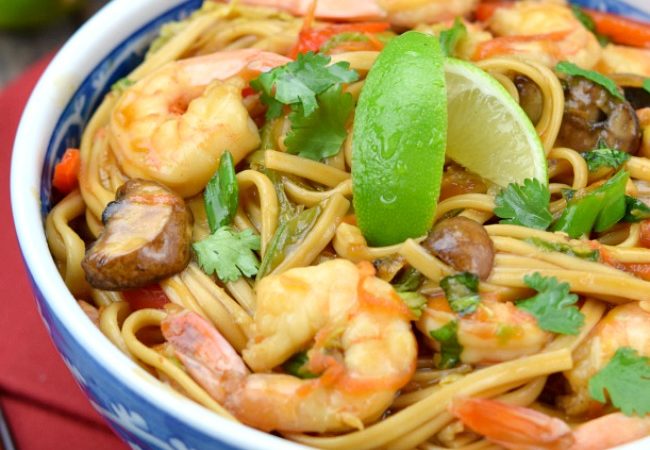
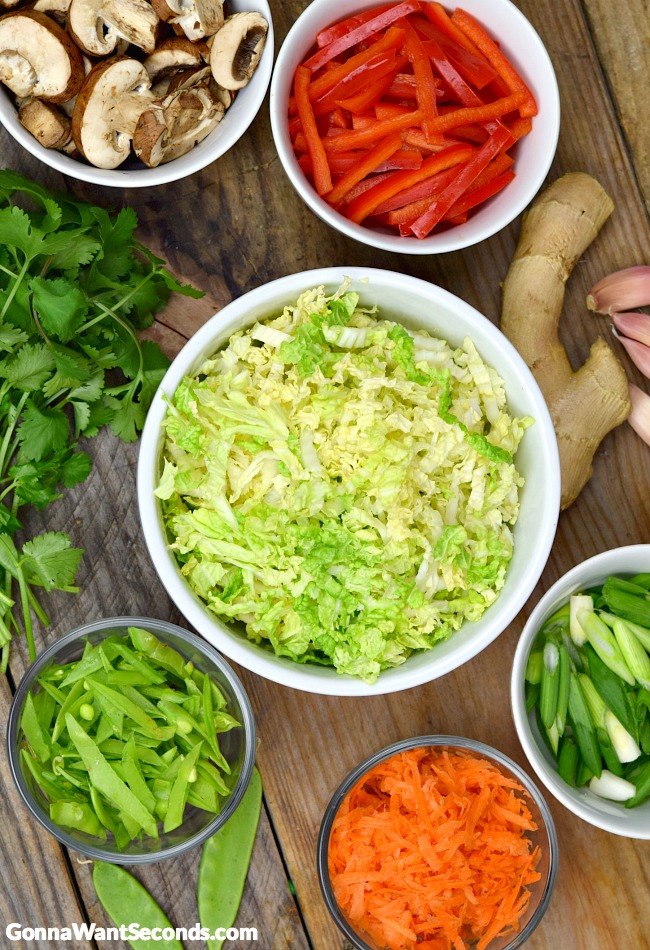
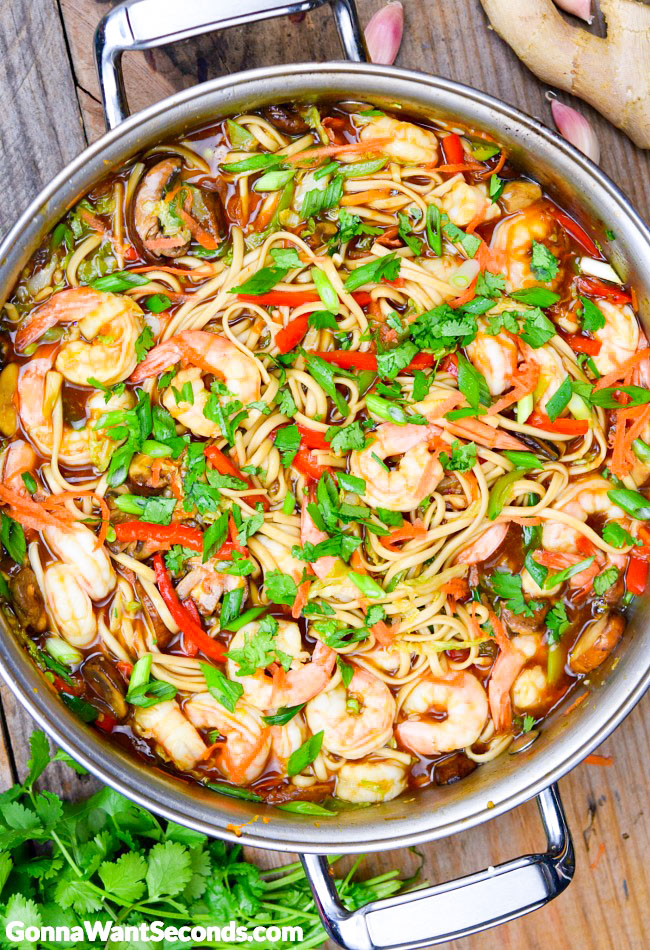
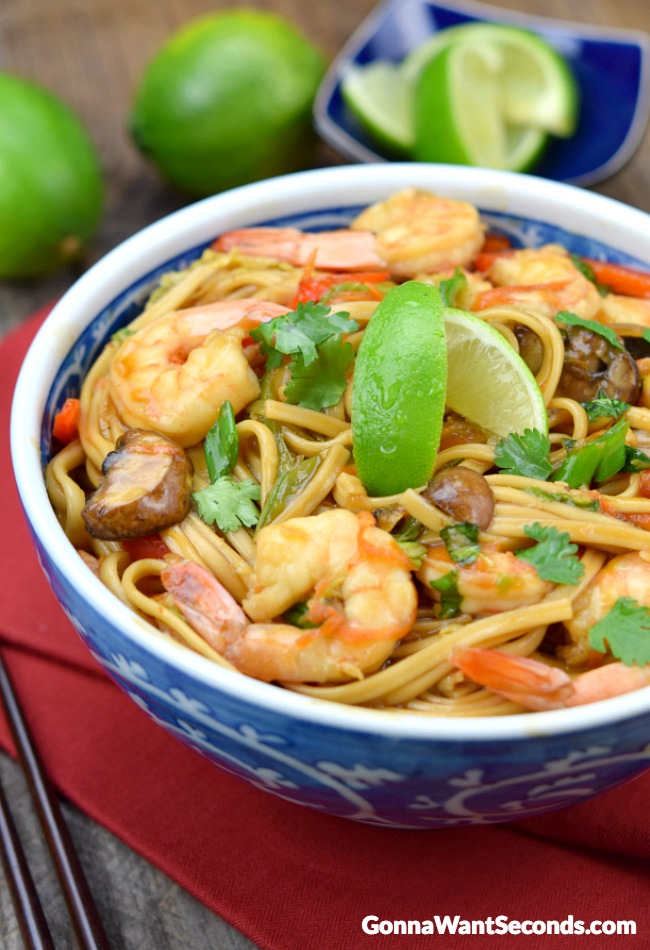
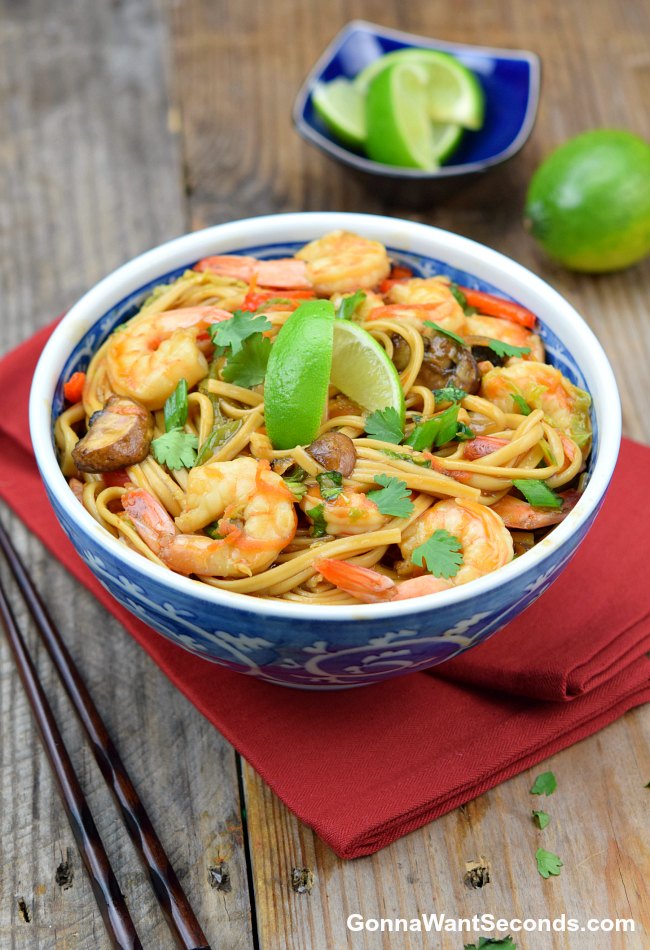
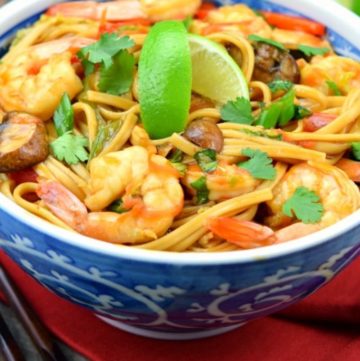


oooohh wow! your photos are amazing, It’s like I can smell it already haha. It’s quick and easy, and the ingredients are easy to get. This is very yummy, savory and umami! Oh my oh my, its very delicious! Sometimes I put sesame seeds on top, just because. A squeeze of lime is perfect! thank you for this!
Thank you Patty 🙂